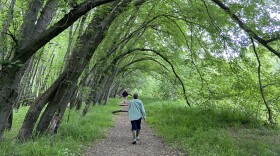The last time New Hampshire was in the direct path of a total solar eclipse was in 1959, and the next one won't be until 2079. It’s a once-in-a-lifetime celestial event that affects wildlife activity, especially birds.
Even with relatively long lifespans, humans rarely experience more than one or two eclipses, unless we deliberately travel to where the eclipses occur.
Most short-lived animals, like mice and squirrels, or even large mammals like moose or bears, never experience more than one solar eclipse. In fact, it's likely the vast majority will never go through a single one.
Since it’s so rare, we don’t know what to expect from birds or other wildlife, but we can set aside the idea that animals make a plan or have some innate knowledge for how to respond when the moon suddenly blocks out the sun.

“As a wildlife biologist, my assumption would be that most animals respond by doing what they’d do normally at sunset,” says Something Wild co-host Chris Martin of NH Audubon. “Day-active creatures like woodchucks or pigeons might go to their dens or roosts, while nocturnal wildlife like bats and owls might actually get more active.”
In the August 21, 2017, total solar eclipse that tracked from the Pacific Northwest to the southern Atlantic area the period of totality was 2 minutes 40 seconds. This year, with the moon even closer to the earth, most areas in the direct path will have 3 ½ to 4 minutes of darkness.
One of the most exciting aspects of the 2024 eclipse for researchers is that it is occurring during spring migration, when birds are returning to their northerly breeding grounds. Most bird migration usually happens at night, prompted by a drop in temperature and changes in light levels.
The widespread change in light and temperature of an eclipse is something that scientists can’t simulate in an experiment. They're eager to observe how animals and birds react.
During the 2017 eclipse, researchers from Cornell University noticed some things that we might see here in New Hampshire in 2024. Birds that use thermals for soaring, like turkey vultures and red-tailed hawks, tended to go to roost during that eclipse.
Thermals result from the sun heating the ground and creating a warm column of rising air; perhaps the darkness and drop in temperatures causes them to anticipate the thermals going away, just as they do every night around sunset.
Swallows and purple martins forage for insects during flight, and in 2017 the researchers noticed that these birds also left the sky during totality. The scientists were impressed by the magnitude of the response: enough birds that had been swooping around the sky quickly coming to ground showed up clearly on radar.

On the other hand, many other birds appeared to show little response during the 2017 eclipse. The Cornell researchers thought many birds seemed to be reacting like they would at sunset, or in the dimming light of an approaching storm, perhaps the closest equivalents to a solar eclipse.
Plenty of people are staging their own “migration,” placing themselves in the path of totality and traveling to the best viewing spots. Unlike all other lifeforms on Earth, humans have the benefit of prior knowledge and experience of the total solar eclipse.
If you would like to get involved in some citizen science and share your observations about how you see birds or animal behavior change during the eclipse, you can collect data for NASA.
You can also create your own “path of totality” every night and help migrating birds - eclipse or not - by just turning off your outdoor lights!
Something Wild is a partnership of the Forest Society, New Hampshire Audubon, and NHPR.











